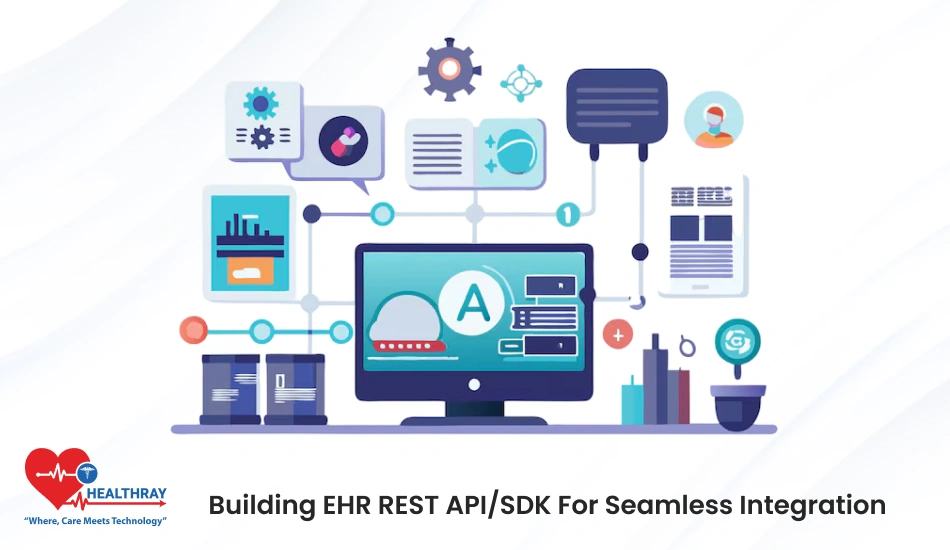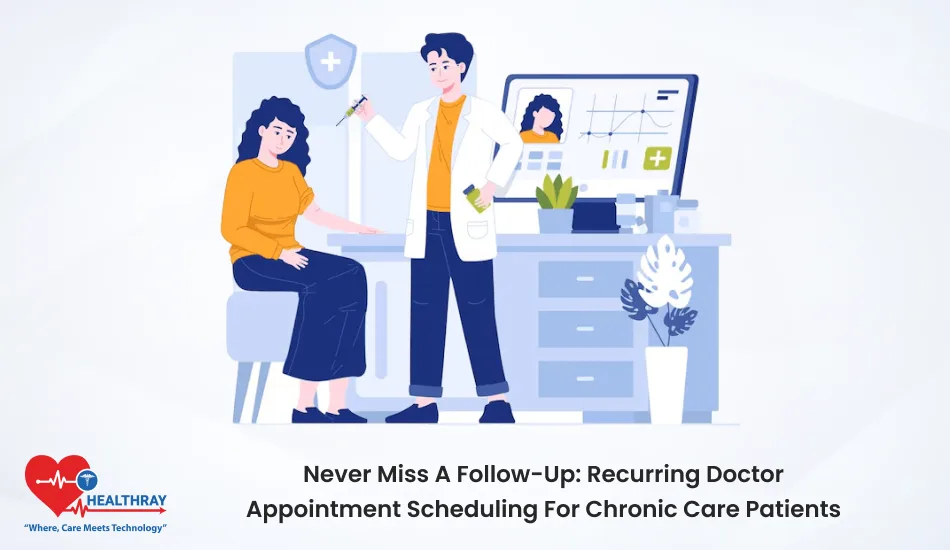Summary
This article describes the ways in which a robust EHR REST API/SDK can revolutionize hospital systems. It demonstrates how uncluttered design, simple API endpoints and secure authentication make your EHR software more usable and integratable.
Standards, architecture and modularity to help good workflow are addressed in the guide. Best practices such as versioning, change logs, backward compatibility, ongoing security testing, promote stability and reliability. Hospitals benefit from speed, reduced errors, better staff efficiency. And lastly, a quality EHR REST API/SDK is what will keep your EHR software adaptable, up-to-date and reputable in healthcare settings for seamless digital interoperability.
Introduction
Imagine!
Your hospital team kicks off your day, and all connect smoothly. Doctors open charts quickly. It takes seconds for nurses to fill in notes. Billing accesses real-time data. Plus, they’re designed to work with the EHR software you already use and easily set up. This seamless experience is enabled by your EHR REST API/SDK, which connects all systems in real time.
Now, let us imagine the opposite scene. Your team is waiting for the records to load. The lab is late sending test results to the doctor. The new apps are out of sync. IT spends hours troubleshooting old connection issues. Such problems slow care, increase stress and block growth.
Which is why you can see the importance of a powerful API and SDK. They minimize labour, enable new processes and help rapid communication across your hospital.
Let’s take a look at how to build that foundation with clarity and confidence.
What is an EHR REST API/SDK?
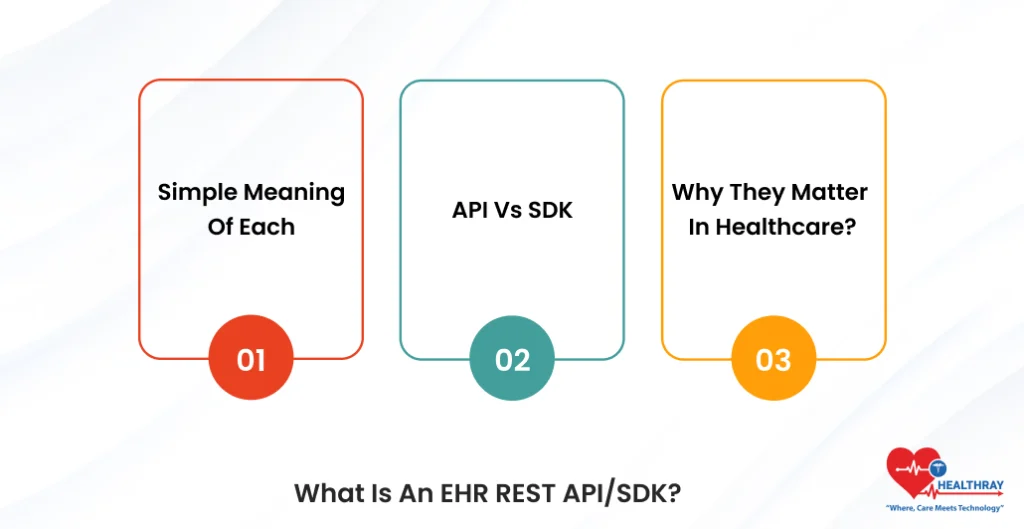
Simple Meaning of Each
Let’s begin with a simple idea. Hospitals require rapid, clean, safe data transfer on a daily basis. Many teams call this goal digital flow, and this flow keeps the process smooth and stress-free. Now, your EHR software is at the center of this daily movement, so it must connect with many tools. This is where the EHR REST API/SDK helps your team very clearly.
An API (Application Programming Interface) provides clear paths and doors through which data can flow into and out of a system. An SDK (Software Development Kit) supplies ready helpers, snippets of code and documentation to ease a developer’s ability to integrate more quickly. When hospitals blend the two, work becomes lighter, cleaner, and safer for busy teams.
This mix also promotes strong EHR UI/UX optimization because the data flows uninterrupted across all screens. You use this blend to distribute charts, notes, links to new tools, and nurture new ideas. And yes, this work becomes easier after every EHR demo & free trial guide because your team learns what improvements they really need.
API vs SDK
Let’s compare the two in a simple way. An API provides the rules, routes, and actions for safely sharing and receiving information. You use it when your system has to talk to another system. An SDK, on the other hand, provides ready tools to help developers ship faster instead of messing with complex code. You can think of it as an API is the road and an SDK is the car that goes on that road.
Hospitals often need both because both help improve EHR UI/UX optimization in busy environments. An API alone helps, but an SDK removes confusion, sets you back from time and reduces stress on your IT teams. Together, they can make your software for electronic health records more adaptable and easier to update on a flexible schedule. And yes, these tools feel even more useful when your team studies new options through an EHR demo & free trial guide.
Why They Matter in Healthcare?
Hospitals expand rapidly, and new digital tools come on line every year. Your systems have to run at that speed. You need clean mobility of data, seamless scheduling, clean charting updates, and onboarding of tools. The right blend makes it easy to upgrade without a ton of work or waiting forever.
This combination lowers the manual labor and mistakes, while freeing up your staff to be with patients. You also get easier updates, cleaner dashboards, easier connections to devices, and easier onboarding of new vendors. And yes, you gain stronger digital trust because everything stays transparent and predictable.
Core Functions, Standards, and Architecture of an EHR REST API/SDK
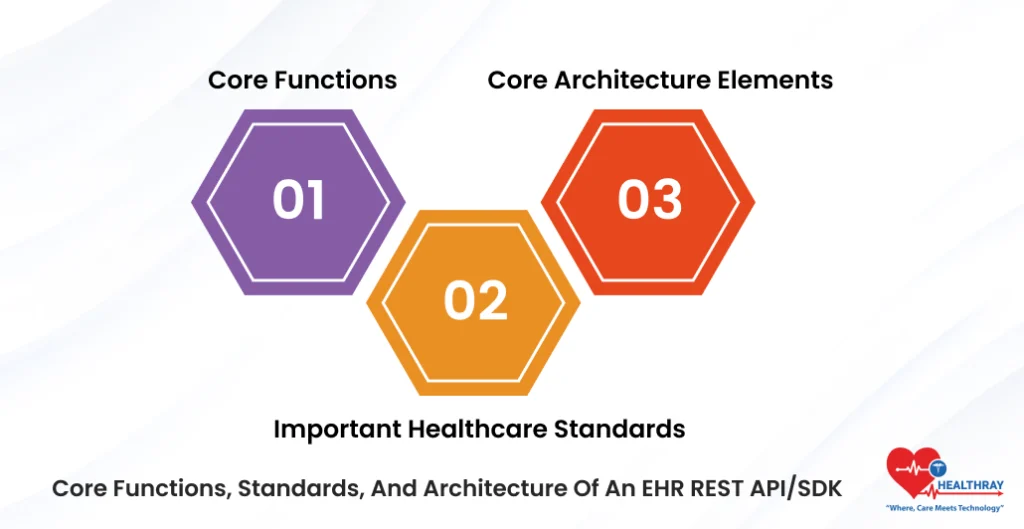
A strong EHR REST API/SDK must combine the right functions, follow key healthcare standards, and use a solid technical structure. All three parts work together to create smooth and secure integrations.
Core Functions
- Patient data access: Easy, fast, and secure patient record retrieval.
- Appointments and scheduling: Create, update, cancel, and track visits.
- Clinical notes and documentation: Add and view doctor notes and reports.
- Billing and claims: Share billing data with other apps safely.
- User authentication and roles: Control who can see or change data.
Important Healthcare Standards
- HL7 FHIR: Standard format for patient data exchange.
- SMART on FHIR: Lets external apps connect safely to EHR systems.
- OAuth 2.0: Secure login and token-based access.
- HIPAA/ISO compliance basics: Protect data privacy and security.
Core Architecture Elements
- Backend services: Handle requests, store data, and run logic.
- Data flow: Move information between apps and the EHR smoothly.
- API gateways: Manage traffic, security, rate limits, and routing.
- SDK language support: Offer SDKs (Java, Python, JavaScript, etc.) for easy development.
How to Design the EHR REST API/SDK for Easy Integration?
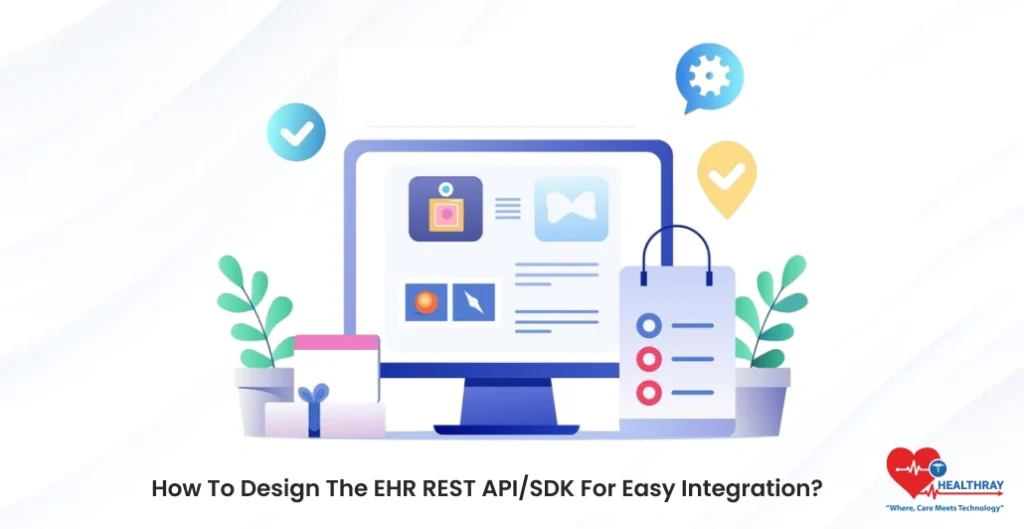
Here are some of the most effective ways through which one can design the EHR REST API/SDK for easy integration:
Start with Clear Goals and a Simple Structure
A good EHR REST API/SDK begins with a purpose and simplicity. Dev teams build complex tools, but devs want simple paths. Your EHR REST API/SDK has to have friendly outputs, short steps and easy calls. Simple design enables more teams to deploy your EHR software without painful learning times. When the structure is clear, more external apps can interface smoothly with your EHR software.
Your objectives should be seamless data movement among all connected systems. You should think about how clinics move data in the course of daily work. And you should consider how quickly developers will be able to understand your EHR REST API/SDK as well.
If your tool is easy, more teams will want to test it using your EHR demo & free trial guide. Clarity also minimizes the risk of developer error while integrating. Once the structure remains simple, updates remain simple. This makes your EHR REST API/SDK more stable for long-term use inside hospitals and clinics.
Use Standard Data Formats for All Exchanges
All work inside any EHR software is done in standard data formats. Your EHR REST API/SDK should comply with normal healthcare protocols. JSON works well because it is lightweight and simple. JSON is familiar to many developers, so it’s easier for them to connect.
Standards also lend themselves to improved EHR UI/UX optimization as they eliminate messy data errors. Your electronic health records software can share information easily when your data formats remain clean. This brings a higher level of trust and lower technical risks.
Clear formats also assist developers in piloting new ideas using your EHR demo & free trial guide. They can experiment with features, compare outputs, and debug faster. By your EHR REST API/SDK not being proprietary and based on standards, you minimize integration costs for all of your partners.
Standard formats also enable safe updates as they do not allow sudden changes in data shape. This prevents any disruption to your EHR whenever other modules come onto your platform.
Create Clear Authentication and Strong Access Rules
Your EHR REST API/SDK should maintain the privacy of sensitive patient information at all times. Good authentication builds trust for everyone who uses your EHR software. Developers like simple flows, which is why OAuth 2.0 continues to be a good option. Clear tokens help reduce ambiguity and enhance EHR UI/UX optimization in secure tasks.
All access rules should restrict sensitive information. But e-records have to let in only the data that is necessary. Strict protocols ensure safety in the practice on a daily basis. These rules also serve to guide partners in the early testing using your EHR demo & free trial guide. Clear authentication also leads to fewer coding errors. Keeping rules simple makes your EHR REST API/SDK easier to work with for new developers.
Make Your Endpoints Easy, Predictable, and Human-Friendly
Your endpoints have to feel natural to any developer. A good EHR REST API/SDK uses short names, clear resources and stable patterns. Clean endpoints minimize support calls within your EHR software.
When endpoints remain stable, developers are able to build faster apps using your software for electronic health records. Predictable patterns also help during your EHR demo & free trial guide when teams explore features. They are able to access platform, test calls, and response data in minutes. Predictable endpoints give your EHR REST API/SDK a modern and friendly feel. This creates sustainable use in many clinics and partners.
Keep Error Messages Short, Clear, and Helpful
Clear errors lead to faster debugging. Your EHR REST API/SDK error responses should be simple error codes with hints. These provide cues when working in your EHR software in the beginning stages. Wording like this enhances the experience and supports the EHR UI/UX optimization by eliminating ambiguity.
Identifiable error patterns also make your electronic health records software more seamless in actual use. If errors seem predictable, the developers trust your system more. Good error messages show that your EHR REST API/SDK has developer comfort in mind.
Document Everything in Simple Words and Clean Examples
The documentation is at the core of EHR REST API/SDK. Developers prefer clean examples and clear steps, and simple words. Each section should show how your EHR software integrates with actual scenarios. Good documentation also leads to smoother EHR UI/UX optimization, as knowing removes the time spent on guessing.
Your samples must contain actual data from electronic health records software. Your EHR demo & free trial guide should also include information on how new users can test requests. Well-documented API support loads on your support staff. When your EHR REST API/SDK is well documented, adoption is nearly frictionless.
Step towards digital era with our healthcare solution
Revamp your hospital facilities and embrace change for better healthcare management. Ease in managing and organizing large medical datasets leads to effective analysis. Seize the opportunity now!
Plan for Scalability from Day One
A good EHR REST API/SDK should be able to grow without stress. Your system has to remain fast under peak load. Scalability that works is found in EHR software that is accessible when needed and performs well under all circumstances. It also lends itself to better EHR UI/UX optimization, because users like fast screens.
Scalability enables many teams to simultaneously access your software for electronic health records. It also helps developers when your EHR demo & free trial guide is used in early testing. When a system scales well partners trust your tools and plan deeper integrations. The key to sustainable future growth is strong scaling patterns.
Allow Custom Workflows for Different Healthcare Needs
Different clinics like different workflows. Your EHR REST API/SDK should give you flexibility on these tasks for either group. It also provides additional value to your EHR. It also helps EHR UI/UX optimization because users get used to customised screens and flows.
This is important for any electronic health record software, since medical teams have their own specific workflows. You can check out these custom options in your EHR demo & free trial guide. When flexibility comes, it is less clunky, and it forms deeper integration. This flexibility is one of the core strengths of your EHR REST API/SDK.
Best Practices for Long-Term Maintenance
- Keep your EHR REST API/SDK and updates as well as EHR software in version control.
- Label versions to aid in EHR interface and user experience improvement as well as stable electronic health record software.
- Keep a log of changes and bug fixes; see your EHR demo & free trial guide.
- Maintain backward compatibility so that existing tools can be used and existing workflows are not interrupted.
- Continuously test security, in order to protect data, to reduce errors and maintain the trust of the hospital.
- Ensure regular updates to security and documentation, as well as constant monitoring for safe and sustainable long-term use.
Conclusion
Building a strong EHR REST API/SDK transforms hospital systems and supports modern healthcare needs. Proper design, clear endpoints, and simple authentication make your EHR software easier to use. Following best practices like version control, change logs, backward compatibility, and continuous security testing ensures stable and trusted systems.
Good EHR UI/UX optimization helps staff work efficiently and reduces errors. Your software for electronic health records becomes future-ready and flexible for new tools. A strong EHR REST API/SDK is the foundation for digital hospital success.
